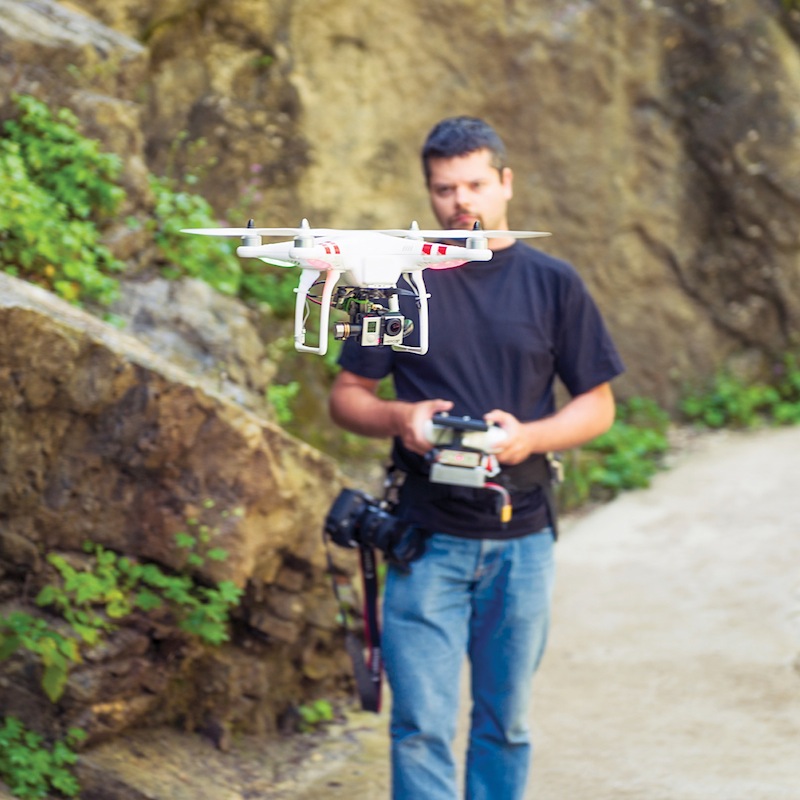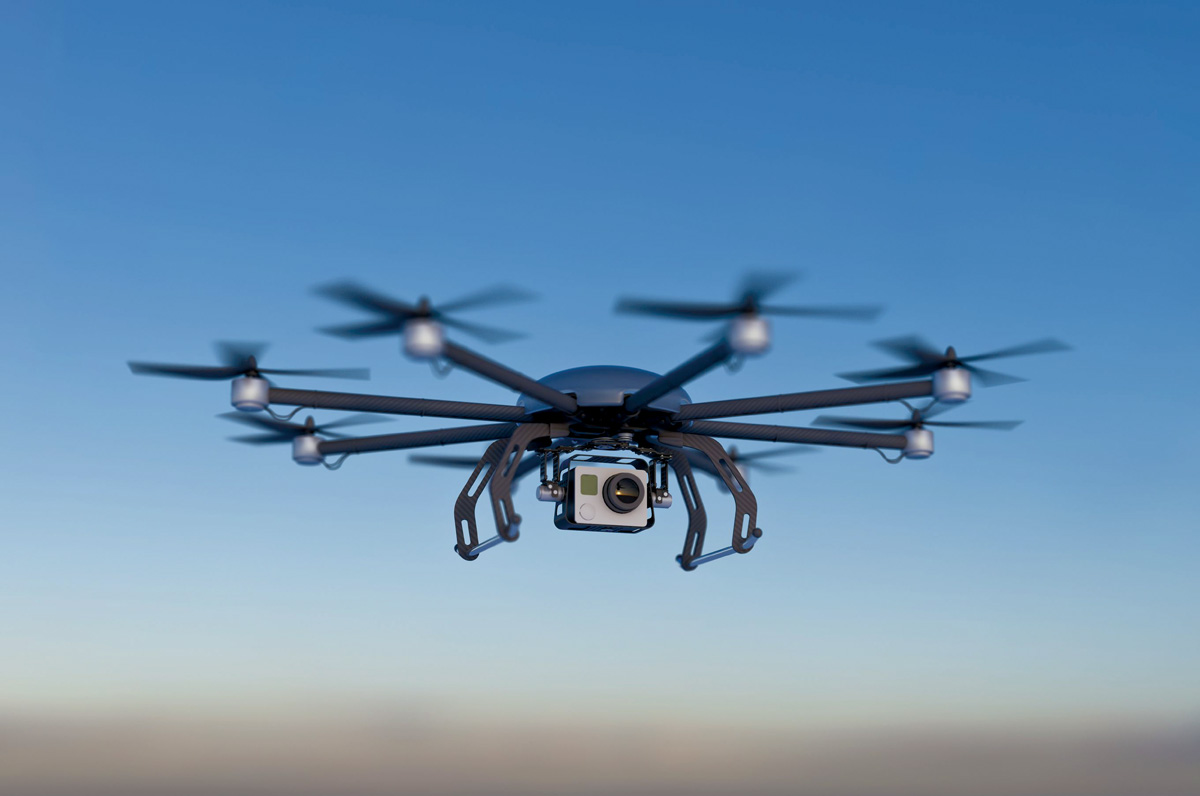The use of drones as construction tools took a big step forward on February 15, when the Federal Aviation Administration issued its Notice of Proposed Rulemaking for Small Unmanned Aircraft, which offers safety rules for drones weighing more than 55 pounds conducting non-recreational operations. And on May 6, FAA announced its Pathfinder Program, where it will work with the market to gather data to make the case for allowing drone flights for expanded commercial operations without permission.
While they wait for rules to be finalized and approved, companies wanting to fly drones are taking advantage of an exemption process that FAA streamlined last year. St. Louis-based design/build contractor Clayco, and Bechtel, North America’s largest civil engineering and construction company, are recent exemptees.
FAA is working with insurance companies to develop coverage and policy standards, says Jay Shelton, Senior Vice President and Leader of Risk Management Practice at Assurance, a Chicago-based insurance brokerage. He knows of only one carrier, Lexington Insurance, that offers a modified aviation policy covering drones.
Both Clayco and Bechtel integrate drones into their execution systems via Skycatch’s cloud-based platform for capturing data using small automonous aerial robots. Skycatch is also partnering with Komatsu, the Japanese construction equipment colossus, which in January unveiled plans to use unmanned aircraft, bulldozers, and excavators to automate early foundation work on construction sites. Komatsu intends to lease at least 200 drones from Skycatch.
FAA has estimated that between 7,500 to 20,000 drones could be permitted to fly legally by 2020. But issues around usage (such as rights of way), liability, and privacy still need to be resolved.
FAA is working with insurance companies to develop coverage and policy standards, says Jay Shelton, Senior Vice President and Leader of Risk Management Practice at Assurance, a Chicago-based insurance brokerage. He knows of only one carrier, Lexington Insurance, that offers a modified aviation policy covering drones.
Shelton believes that drone-related privacy issues in all likelihood will be sorted out by courts to determine, for example, whether an intrusion was accidental or intentional, or whether release forms are required before drones can fly over or photograph buildings or land.
“There are grey areas, but the benefits [of using drones] are unquestionable,” says Steven Lesser, Shareholder in charge of construction at the Fort Lauderdale, Fla.-based law firm Becker & Poliakoff, and Vice Chairman of the American Bar Association’s Forum on Construction Law.
 Photo: Association of Unmanned Vehicles International
Photo: Association of Unmanned Vehicles International
Lesser says AEC firms are eager to fly drones because robots make it easier and safer to access difficult areas like mining pits or rough terrain, at a fraction of what an airplane or helicopter would cost to rent.
“The possibilities are amazing,” says James Brogan, AIA, Director of Firmware Technology for Kohn Pedersen Fox Associates. His firm completed work on an airport in Nanking, China, from which Chinese construction partners sent progress reports in the form of drone-shot videos.
Wiss, Janney, Elstner Associates also is waiting for the FAA to finalize the regs on drone use, says IT Manager Raymond Jaskot. He thinks drones could be useful in high-risk construction environments where safety is problematic. Drones could also aid in measuring and inspecting buildings. Jaskot says WJE has looked into using drones with infrared cameras to detect temperature variations that could be caused by moisture trapped behind a façade.
One drone maker, France-based Sysveo, is working on software that would give drones the capability to include augmented reality 3D images in their videos, so developers could see what a building project might look like well before it exists.
“It’s critical that our technology portfolio stays ahead of the curve,” says J. Brent Williams, President of Burns & McDonnell, which began using drones in 2013, and now owns six. The firm recently entered into a partnership with Yale University to show students how drones and sensors can work in tandem. “We have the ability to switch out sensors on UAVs [unmanned aerial vehicles] from a regular camera to a near-infrared to a four-band multispectral,” says Steve Santovasi, GISP, who manages the firm’s Geospatial Services department. These options “give us the ability to visualize or categorize from bandwidths outside the limits of the human eye,” he says.
Other AEC firms see drones as enhancing their design abilities. “If you have a drone working off of a Revit model, it could show you detail areas and tie that with augmented reality as well as overlay the next construction layer,” states Robert Petty, Associate Partner at ZGF Architects, who owns a couple drones for personal use. Theoretically, he says, a designer armed with that information “could change the design on the spot with 3D printing and relay the information to robotic manufacturing.”
Peter Marchese, a Senior Consultant with Microdesk, has fed a CAD/BIM model into a drone to lay out paint lines for a building. He uses drones for reality capture to create models with Autodesk or Pix4D process imaging software. Drones could aid clash detection, too, Marchese suggests.
Marchese recommends that firms considering using drones should first train their pilots on simulation programs like Real Flight or Phoenix, and then fly the drones with two-man teams. Mark Segal, who owns the aerial photography firm Skypan, says his company always flies drones with a pilot, an assistant, and a spotter.
Segal anticipates “lots of opportunities and purposes” for drones in construction and renovation, including inspecting existing buildings. He notes that there’s been “enormous improvement” in drone stability and sophistication, and cites the new Solo drone from 3D Robotics, outfitted with a GoPro camera that an operator can control from a distance of a half-mile.
Battery technology is a concern, though. Drones use lithium polymer batteries that are sensitive to charging, and can ignite. And smaller prop drones can’t stay airborne for more than 20 minutes, tops.
Segal thinks Tesla Motors’ battery technology—its massive factory in Nevada should be fully operational by 2020—could lead to breakthroughs in battery life for UAVs. For now, he says, battery power is adequate for most AEC firms’ drone uses: “They only need to be in the air for five or six minutes at a time to get what you need.”
Next on the horizon: obstacle detection and avoidance technology, so operators can fly UAVs safely even when they’re out of sight.
MEET DRONE EXPERTS AT BUILDING HEARTLAND
Microdesk’s Peter Marchese and SkyPan’s Mark Segal will speak on “DRONES: How Design, Engineering + Construction Firms—and Their Clients—Can Benefit from Their Use” at BD+C’s Building the Heartland conference, September 1, 2015. More at: www.BuildingChicagoExpo.com.
Related Stories
| Aug 11, 2010
Luxury Hotel required faceted design
Goettsch Partners, Chicago, designed a new five-star, 214-room hotel for the King Abdullah Financial District (KAFD) in Riyadh, Saudi Arabia. The design-build project, with Saudi Oger Ltd. as contractor and Rayadah Investment Co. as developer, has a three-story podium supporting a 17-story glass tower with a nine-story opening that allows light to penetrate the mass of the building.
| Aug 11, 2010
Architectural Visualization Rendering the Future
Three-dimensional design tools have revolutionized the way architects and engineers design buildings; in recent years, parametric modeling has enabled Building Teams to impart weight tolerances and other intelligent information to a finished design. Yet many designers say they use 3D most in the conceptual design stage, when detailed building information is not necessary and can actually encumb...
| Aug 11, 2010
Big-time BIM
As the need for new state, county, and municipal facilities keeps growing and funding for public building construction continues to shrink, state and local officials are left with two basic options: renovate dilapidated older buildings and hope for the best, or build new facilities on anemic budgets.
| Aug 11, 2010
Dotting the I in IPD
Collaboration software is going beyond just sharing files. It is being used to enable full building information modeling early in design. Two programs are enabling Building Teams to more easily share the information in BIM and use it for integrated project delivery: Bluebeam Software, which just released the newest version of its AEC-specific PDF collaboration tool; and eBuilder Enterprise, a W...
| Aug 11, 2010
Great Solutions: Business Management
22. Commercial Properties Repositioned for University USE Tocci Building Companies is finding success in repositioning commercial properties for university use, and it expects the trend to continue. The firm's Capital Cove project in Providence, R.I., for instance, was originally designed by Elkus Manfredi (with design continued by HDS Architects) to be a mixed-use complex with private, market-...
| Aug 11, 2010
BIM adoption tops 80% among the nation's largest AEC firms, according to BD+C's Giants 300 survey
The nation's largest architecture, engineering, and construction companies are on the BIM bandwagon in a big way, according to Building Design+Construction's premier Top 50 BIM Adopters ranking, published as part of the 2009 Giants 300 survey. Of the 320 AEC firms that participated in Giants survey, 83% report having at least one BIM seat license in house, half have more than 30 seats, and near...
| Aug 11, 2010
Thrown For a Loop in China
While the Bird's Nest and Water Cube captured all the TV coverage during the Beijing Olympics in August, the Rem Koolhaas-designed CCTV Headquarters in Beijing—known as the “Drunken Towers” or “Big Shorts,” for its unusual shape—is certain to steal the show when it opens next year.
| Aug 11, 2010
Great Solutions: BIM/Information Technology
4. Architectural Visualization through Gaming Technology Before 3D walkthroughs for client presentations were popular, HKS manager of Advanced Technologies Pat Carmichael and his team were working to marry gaming engines with 3D building models. "What's being tasked to us more and more is not just to show design, but to show function," Carmichael said.
| Aug 11, 2010
Great Solutions: Collaboration
9. HOK Takes Videoconferencing to A New Level with its Advanced Collaboration Rooms To help foster collaboration among its 2,212 employees while cutting travel time, expenses, and carbon emissions traveling between its 24 office locations, HOK is fitting out its major offices with prototype videoconferencing rooms that are like no other in the U.
| Aug 11, 2010
BIM school, green school: California's newest high-performance school
Nestled deep in the Napa Valley, the city of American Canyon is one of a number of new communities in Northern California that have experienced tremendous growth in the last five years. Located 42 miles northeast of San Francisco, American Canyon had a population of just over 9,000 in 2000; by 2008, that figure stood at 15,276, with 28% of the population under age 18.







